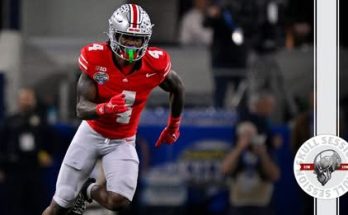The Golden State Warriors have made their stance crystal clear—Jonathan Kuminga is staying put. In a summer already full of NBA headlines, trade rumors, and shifting rosters, the Warriors have shut down any speculation about moving their young forward. The decision to keep Kuminga is not just about avoiding the trade market; it’s a deliberate investment in the team’s future and a belief that the 21-year-old’s best basketball is still ahead of him. In the midst of swirling possibilities that could have seen Kuminga packaged in deals for veteran stars or high-value draft picks, Golden State’s front office has decided that his development, athleticism, and potential two-way impact outweigh any short-term gain from a blockbuster trade. It’s a commitment that speaks volumes about the organization’s long-term vision and its balance between competing for championships now and building for what’s to come.
Jonathan Kuminga’s journey with the Warriors has been one of steady growth, flashes of brilliance, and the kind of raw talent that coaches and executives dream of harnessing. Drafted seventh overall in 2021, Kuminga entered the league as one of the most athletic prospects in his class, known for his explosive leaping ability, defensive versatility, and the physical tools to guard multiple positions. However, playing for a championship-caliber team meant his path to consistent minutes would be challenging. The Warriors’ roster, loaded with veterans like Stephen Curry, Klay Thompson, and Draymond Green, required young players to learn on the fly and adapt to a system that demands high basketball IQ, patience, and unselfish play. Kuminga’s early seasons were marked by moments of brilliance mixed with the growing pains of adjusting to NBA-level decision-making and consistency.
Over time, however, he began to carve out a more defined role. Last season, Kuminga made significant strides in scoring efficiency, defensive awareness, and off-ball movement. He showcased improved shooting mechanics, better timing on defensive rotations, and an ability to slash to the basket in ways that broke down opposing defenses. His versatility allowed head coach Steve Kerr to experiment with lineups, using Kuminga at both forward spots, as a small-ball center in certain matchups, and as a defensive stopper against elite wings. What stood out most was his ability to bring an infusion of energy to the floor—whether it was a momentum-changing dunk, a big block, or a hustle play that electrified the home crowd at Chase Center.
The decision to keep Kuminga also reflects the Warriors’ broader understanding of roster construction in today’s NBA. Athletic, switchable forwards who can contribute on both ends of the court are among the most coveted assets in the league. Trading away a young player with Kuminga’s upside for a short-term veteran boost could backfire, especially if the team wants to remain competitive beyond the current core’s championship window. Stephen Curry is still playing at an elite level, but the front office knows that building a bridge to the future requires keeping younger players who can eventually take on bigger roles. Kuminga, in this sense, is not just a role player—he’s part of the blueprint for sustaining relevance when the veterans eventually pass the torch.
It’s also worth noting that Kuminga himself has expressed a desire for more responsibility and an expanded role. Reports in past seasons hinted at his frustration with limited playing time, but rather than souring the relationship, the Warriors appear to be doubling down on his potential. They’ve seen the maturity in his game and the work he’s put in during the offseason, and they believe he can take the leap into becoming a more consistent nightly contributor. This mutual commitment—Kuminga wanting to grow, and the Warriors willing to give him that platform—could set the stage for a breakout season.
The context of this decision becomes even more interesting when considering the Warriors’ current roster landscape. After bringing in Jimmy Butler this offseason to form a new dynamic trio alongside Curry and Thompson, Golden State’s wing depth is both deep and versatile. Butler’s addition adds another defensive anchor and secondary playmaker, but it also means the Warriors need athletic forwards who can space the floor, defend multiple positions, and run the floor in transition. Kuminga fits that bill perfectly. While Butler, Curry, and Thompson handle much of the offensive orchestration, Kuminga can thrive as a slasher, cutter, and transition finisher while continuing to refine his jumper. Defensively, his ability to switch onto guards and wings makes him invaluable in a league increasingly dominated by perimeter-oriented play.
Another reason the Warriors are holding onto Kuminga is the reality of the Western Conference landscape. Teams like the Denver Nuggets, Minnesota Timberwolves, and Oklahoma City Thunder boast size, athleticism, and young legs that can run for 48 minutes. To keep pace and counter those advantages, Golden State needs someone like Kuminga who can meet that athleticism head-on. His presence on the floor changes the Warriors’ defensive ceiling, giving them a player who can help neutralize top scorers without sacrificing offensive firepower. In playoff basketball, where matchups dictate outcomes, having a player with Kuminga’s skill set can be the difference between advancing or going home early.
From a developmental perspective, the Warriors have also shown that they value patience when it comes to their young talent. The same way they nurtured Jordan Poole’s game before he became a key playoff contributor, or how they integrated Moses Moody into the rotation, they’re giving Kuminga time to refine his craft without the pressure of carrying the team right away. This approach is part of Golden State’s “two-timeline” strategy—a delicate balancing act of competing for titles now while grooming the next generation. In this equation, Kuminga is perhaps the most pivotal piece, given his age, athletic profile, and potential to be a two-way star.
The choice to keep Kuminga has already sparked conversations around the league. For rival GMs and scouts, it’s a signal that Golden State sees something special and is unwilling to part with it for anything less than a perfect deal. That kind of confidence can have a psychological effect—it tells the player, “We believe in you,” and it sends a message to the rest of the team that the front office is committed to continuity and trust in their developmental system. For Kuminga, it’s both a vote of confidence and a challenge. The team has placed its faith in him, and now it’s on him to deliver, to bring that consistency every night, and to prove that he can be more than just a promising young talent.
As training camp approaches, all eyes will be on how Kuminga integrates into the Warriors’ new-look rotation. With Butler in the mix, Draymond Green returning as the defensive quarterback, and Curry continuing to lead the offense, there will be plenty of opportunities for Kuminga to shine without the weight of being the primary option. This is a season where his athleticism, improved skill set, and growing basketball IQ can turn him from a bench spark into a reliable starter or high-minute contributor. If he can combine his physical gifts with the mental discipline needed to excel in Kerr’s system, Kuminga’s impact could be felt in ways that extend far beyond the box score.
The Warriors’ refusal to trade Jonathan Kuminga this summer isn’t just a front-office decision—it’s a statement of philosophy. In a league where instant gratification often trumps patience, Golden State is betting on the long game. They’re betting that keeping Kuminga, nurturing his growth, and integrating him into the heart of their system will pay off not only in this season’s playoff run but also in the seasons to come. With the Western Conference as competitive as ever and the Warriors looking to maximize the remaining prime years of Curry, Thompson, and Green, Kuminga represents both the present and the future. He’s the athletic link between eras, the player who can run with the young guns and battle with the seasoned stars, the piece that might just keep Golden State’s championship window open a little longer.
If the Warriors’ gamble pays off, this summer’s decision could be remembered as the turning point in Kuminga’s career—the moment when the organization fully embraced him as a cornerstone rather than a trade chip. And for fans, it’s another reason to believe that the dynasty still has life, not just for the season ahead but for years to come. The Warriors have locked in their future, and Jonathan Kuminga is right at the center of it.



